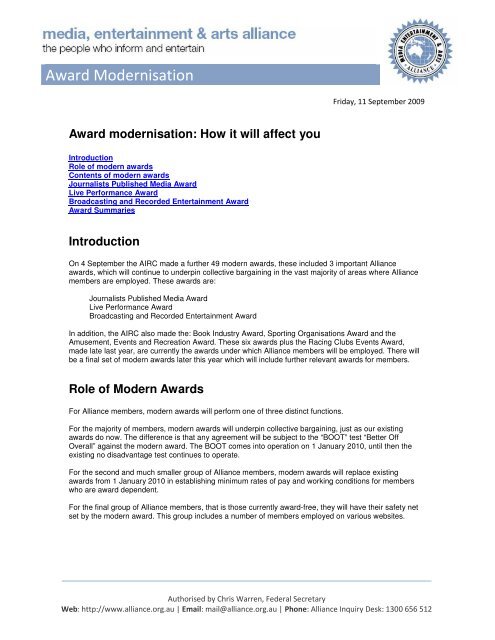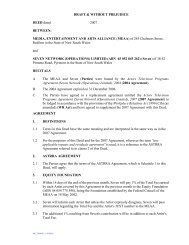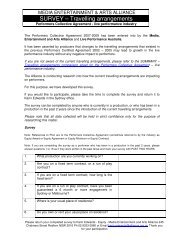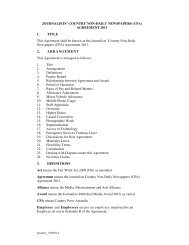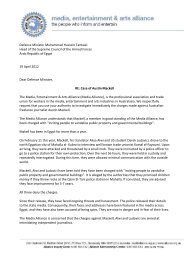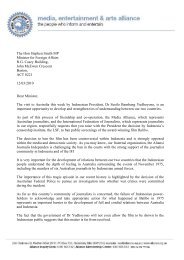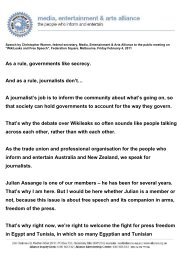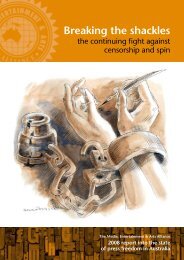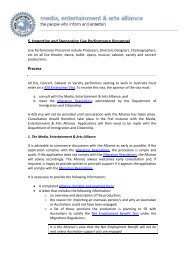Award Modernisation - Media, Entertainment and Arts Alliance
Award Modernisation - Media, Entertainment and Arts Alliance
Award Modernisation - Media, Entertainment and Arts Alliance
You also want an ePaper? Increase the reach of your titles
YUMPU automatically turns print PDFs into web optimized ePapers that Google loves.
<strong>Award</strong> <strong>Modernisation</strong><br />
Friday, 11 September 2009<br />
<strong>Award</strong> modernisation: How it will affect you<br />
Introduction<br />
Role of modern awards<br />
Contents of modern awards<br />
Journalists Published <strong>Media</strong> <strong>Award</strong><br />
Live Performance <strong>Award</strong><br />
Broadcasting <strong>and</strong> Recorded <strong>Entertainment</strong> <strong>Award</strong><br />
<strong>Award</strong> Summaries<br />
Introduction<br />
On 4 September the AIRC made a further 49 modern awards, these included 3 important <strong>Alliance</strong><br />
awards, which will continue to underpin collective bargaining in the vast majority of areas where <strong>Alliance</strong><br />
members are employed. These awards are:<br />
Journalists Published <strong>Media</strong> <strong>Award</strong><br />
Live Performance <strong>Award</strong><br />
Broadcasting <strong>and</strong> Recorded <strong>Entertainment</strong> <strong>Award</strong><br />
In addition, the AIRC also made the: Book Industry <strong>Award</strong>, Sporting Organisations <strong>Award</strong> <strong>and</strong> the<br />
Amusement, Events <strong>and</strong> Recreation <strong>Award</strong>. These six awards plus the Racing Clubs Events <strong>Award</strong>,<br />
made late last year, are currently the awards under which <strong>Alliance</strong> members will be employed. There will<br />
be a final set of modern awards later this year which will include further relevant awards for members.<br />
Role of Modern <strong>Award</strong>s<br />
For <strong>Alliance</strong> members, modern awards will perform one of three distinct functions.<br />
For the majority of members, modern awards will underpin collective bargaining, just as our existing<br />
awards do now. The difference is that any agreement will be subject to the “BOOT” test “Better Off<br />
Overall” against the modern award. The BOOT comes into operation on 1 January 2010, until then the<br />
existing no disadvantage test continues to operate.<br />
For the second <strong>and</strong> much smaller group of <strong>Alliance</strong> members, modern awards will replace existing<br />
awards from 1 January 2010 in establishing minimum rates of pay <strong>and</strong> working conditions for members<br />
who are award dependent.<br />
For the final group of <strong>Alliance</strong> members, that is those currently award-free, they will have their safety net<br />
set by the modern award. This group includes a number of members employed on various websites.<br />
Authorised by Chris Warren, Federal Secretary<br />
Web: http://www.alliance.org.au | Email: mail@alliance.org.au | Phone: <strong>Alliance</strong> Inquiry Desk: 1300 656 512
Contents of Modern <strong>Award</strong>s<br />
Our approach to award modernisation was not to regard this as an opportunity to renegotiate the terms of<br />
existing awards, but to maintain, as much as the legislation permitted, existing provisions. To a large<br />
extent, following discussions with employers <strong>and</strong> their representatives, employers adopted a similar<br />
position. As a result, the three major modern awards largely reflect existing terms, however, there are<br />
some important differences.<br />
Journalists Published <strong>Media</strong> <strong>Award</strong><br />
“This award covers employers throughout Australia in the published media industry with respect to their<br />
employees engaged in journalism in its literary, artistic <strong>and</strong> photographic branches <strong>and</strong>/or the gathering,<br />
writing or preparing of news matter or commentaries, <strong>and</strong> their employees in the classifications listed in<br />
clause 13 – . magazines, periodicals, journals <strong>and</strong> online publications, <strong>and</strong> the provision of wire services.<br />
“Editorial employees” include reporters, writers, photographers, sub-editors, cartoonists, artists, video<br />
journalists, moderators of blogs on news websites, editorial content producers for online publications,<br />
chiefs of staff, picture editors, designers <strong>and</strong> production managers.<br />
Rates of pay – the award has a 13 grade structure which equates to 10 grade structure in News, Fairfax,<br />
AAP, Pacific Publications awards. Schedule A to the award sets out the translation table for the various<br />
existing awards to the new structure. The minimum rates of pay are identical to the rates in the<br />
metropolitan dailies awards, ranging from $698.20 per week for a Grade 1 to $1351.30 per week for a<br />
Grade 13 (MDN Grade 10). The other awards slot in at various levels, however, their maximum levels are<br />
less than 13 <strong>and</strong> reflect existing rates. The 3 B<strong>and</strong> structure is continued with existing definitions.<br />
Allowances – in the main existing allowances continue, in particular, meals, transfers, clothing, air travel,<br />
spectacles, special risks insurance <strong>and</strong> use of office vehicles.<br />
Higher Duties – the award establishes a higher duties payment in the following terms: “When an<br />
employee is called upon to do the work of another in a higher position or award level for more than two<br />
weeks they will be paid the higher rate as prescribed in clause 14 – Minimum wages.”<br />
Casuals – the AIRC has established a st<strong>and</strong>ard casual provision for all modern awards where the casual<br />
rate has a 25% loading of the relevant classification rate with a minimum engagement or payment of four<br />
hours. This is the case here.<br />
Hours of Work – the modern award picks up the existing provisions concerning the methods of working<br />
the 38 hour week, except for currently award-free employees. Distant engagement provisions continue for<br />
those areas currently entitled to it.<br />
Shift Penalties <strong>and</strong> Overtime – Shift penalties remain as is <strong>and</strong> overtime is based on the News Limited<br />
Metropolitan Newspapers <strong>Award</strong> provisions, that is, the preference is for overtime, other than a sixth shift,<br />
to be compensated as time off in lieu. If TOIL cannot be given off within 12 months or there is untaken<br />
TOIL when an employee’s employment terminates, overtime will be paid out at the appropriate rate. All<br />
time worked on a day off will be paid at double time, with a minimum payment of four hours.<br />
Annual leave – Annual leave of 6 weeks <strong>and</strong> 3 days or 6 weeks continues, provided that where the<br />
employer gives the employee at least 14 days notice that they will not have to work on a public holiday,<br />
other than Good Friday or Christmas Day, “that day will be deemed to be taken as an annual leave day.”<br />
Annual leave loading of 17.5% continues to be paid. The award allows an employer to direct an employee<br />
to take annual leave by the giving of 8 weeks notice, following discussions. An employer is also given the<br />
right to have an annual close-down by the giving of not less than four weeks notice.<br />
Other Forms of Leave <strong>and</strong> Public Holidays – The <strong>Award</strong> makes it clear that the National Employment<br />
St<strong>and</strong>ards govern these areas, with the ability of employees by agreement to substitute alternative days<br />
for prescribed public holidays.<br />
Authorised by Chris Warren, Federal Secretary<br />
Web: http://www.alliance.org.au | Email: mail@alliance.org.au | Phone: <strong>Alliance</strong> Inquiry Desk: 1300 656 512
Live Performance <strong>Award</strong><br />
The Full Bench said at paragraph 94 of its 4 September decision:<br />
“The award contains a number of provisions that were not in the exposure draft. These were largely<br />
agreed between the parties who contributed to the modernisation process. While we still hold concerns<br />
that a number of those provisions are not suitable for inclusion in a modern award, in light of the<br />
agreement between the the employers <strong>and</strong> the employee representatives we have decided to give effect<br />
to their views.”<br />
The award covers employees currently bound by a number of awards in a range of classifications. It says:<br />
“This industry award covers employers throughout Australia in the live performance industry <strong>and</strong> their<br />
employees in the classifications set out in this award to the exclusion of any other modern award.”<br />
“Live performance industry” means producing, including pre-production <strong>and</strong> post-production, staging,<br />
lighting, audio <strong>and</strong> audio/visual, presenting, performing, administration, programming, workshops, set <strong>and</strong><br />
prop manufacture, or otherwise undertaking live theatrical, performance art, operatic, orchestral, dance,<br />
erotic, variety, revue, comedy, multi-media, choral, or musical performances, productions, presentations,<br />
workshops, rehearsals or concerts, including the provision, sale, service or preparation of food or drink<br />
<strong>and</strong> also including selling tickets by any means, for or in or in connection with any such performances,<br />
productions, presentations, workshops, rehearsals or concerts, <strong>and</strong> including the operation of venues or<br />
other facilities, whether permanent or temporary, utilised for such performances, productions,<br />
presentations, workshops, rehearsals or concerts are performed or presented in the presence of an<br />
audience, or are recorded by any means<br />
The award contains a number of general provisions applicable to all employees <strong>and</strong> then specific<br />
provisions applicable to: performers <strong>and</strong> company dancers, musicians, striptease artists <strong>and</strong> production<br />
<strong>and</strong> support staff.<br />
The award has a 15 level classification structure with rates ranging from $543.90 per week for a<br />
production <strong>and</strong> support staff employee in their first 6 weeks of employment to $943.40 per week for a<br />
conductor-leader. Schedule A to the award sets out definitions <strong>and</strong> indicative classifications for the 15<br />
levels.<br />
Most existing allowances for all classifications have been retained, in particular, the existing travel<br />
allowance has been retained.<br />
Overtime <strong>and</strong> penalty rates <strong>and</strong> matters relating to hours of work are dealt with on a classification by<br />
classification basis. Contrary to this, all forms of leave are dealt on an across-the-board basis. It is<br />
essential that all industrial staff ensure that they check both the general provisions <strong>and</strong> classificationspecific<br />
provisions before determining what minimum conditions apply to specific classifications.<br />
The award currently runs to some 47 clauses <strong>and</strong> 4 schedules over 74 pages. The final version will be<br />
longer, once the National Training Wage provisions are settled <strong>and</strong> once transitional provisions are<br />
included.<br />
Authorised by Chris Warren, Federal Secretary<br />
Web: http://www.alliance.org.au | Email: mail@alliance.org.au | Phone: <strong>Alliance</strong> Inquiry Desk: 1300 656 512
Broadcasting <strong>and</strong> Recorded <strong>Entertainment</strong> <strong>Award</strong><br />
If staff thought the Live Performance <strong>Award</strong> was complicated, then this award is the gold st<strong>and</strong>ard in size<br />
<strong>and</strong> detail. As it st<strong>and</strong>s it runs to 78 clauses <strong>and</strong> 8 schedules over 149 pages. The first 26 clauses are of<br />
general applicability <strong>and</strong> then there are specific provisions for: television, commercial radio, journalists,<br />
cinemas, actors, musicians <strong>and</strong> motion picture production.<br />
In its 4 September decision the AIRC explained that like the exposure draft, the modern award does not<br />
contain provisions relating to motion picture laboratories nor film <strong>and</strong> television distribution. In relation to<br />
film <strong>and</strong> television distribution, they say “this area could more adequately be dealt with through the clerical<br />
<strong>and</strong> administrative <strong>and</strong> warehousing <strong>and</strong> storage industries.” If we wish to keep them as specialized area,<br />
we can make a variation application. The Bench said if we wish to keep laboratories then we could do the<br />
same thing. It pointed out these classifications were inserted in 1978 without descriptors <strong>and</strong> “appear<br />
archaic”.<br />
It also said that in relation to actors <strong>and</strong> motion picture production staff, the award contains a number of<br />
provisions not in the exposure draft. This was due our “strong submissions for the retention of provisions<br />
of the current awards which, to us, appear out of place in a modern award. However, as no other parties<br />
made any representations to exclude them, we have decided to include many of the provisions sought by<br />
the MEAA.”<br />
Journalists rates for television <strong>and</strong> commercial radio are taken from the existing Journalists (Television)<br />
<strong>Award</strong>. “The television scale is very similar to the scale found in the Journalists Published <strong>Media</strong> <strong>Award</strong><br />
2010 <strong>and</strong> is, in our view, the more appropriate scale.”<br />
Rates for commercial radio based on audience population have been abolished.<br />
Coverage is as follows:<br />
“This award covers employers throughout Australia in the broadcasting <strong>and</strong> recorded entertainment<br />
industry <strong>and</strong> their employees in the classifications set out in this award to the exclusion of any other<br />
modern award.”<br />
broadcasting <strong>and</strong> recorded entertainment industry means the production (including pre-production<br />
<strong>and</strong> post-production), broadcasting, distribution, showing, making available, <strong>and</strong>/or sale of audio <strong>and</strong><br />
audio/visual content including but not limited to feature films, television programs (including series,<br />
serials, telemovies <strong>and</strong> mini-series), news, current affairs, sport, documentaries, video clips, digital video<br />
discs, television commercials, training films <strong>and</strong> the like whether for television exhibition, theatrical<br />
exhibition, sale to the public, digital media release or release in any other medium.<br />
Again this award protects the safety net for members engaged in this industry <strong>and</strong> also provides a more<br />
than suitable floor for enterprise bargaining.<br />
<strong>Award</strong> Summaries<br />
Modern awards commence on 1 January 2010. The modern awards published to date will be varied<br />
between now <strong>and</strong> then to include a number of provisions, for example, transitional provisions <strong>and</strong> terms of<br />
the national training wage. Summaries will be issued as soon as possible, on the proviso, that they will be<br />
altered if <strong>and</strong> when variations are made to them by the AIRC.<br />
Authorised by Chris Warren, Federal Secretary<br />
Web: http://www.alliance.org.au | Email: mail@alliance.org.au | Phone: <strong>Alliance</strong> Inquiry Desk: 1300 656 512


